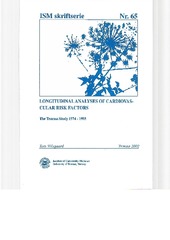Longitudinal analyses of cardiovascular risk factors : the Tromsø study 1974-1995
Permanent link
https://hdl.handle.net/10037/25923Date
2002Type
Doctoral thesisDoktorgradsavhandling
Author
Wilsgaard, TomAbstract
The present study has addressed longitudinal changes in cardiovascular risk factors and also
assessed the association between BMI change with changes in other risk factors.
We showed a moderate to high degree of tracking for systolic and diastolic blood
pressure, HDL cholesterol, total cholesterol, and triglycerides and a higher degree of tracking
for BMI. Tracking was higher for total cholesterol compared to HDL cholesterol, especially in
men. Tracking was slightly higher for systolic blood pressure than for diastolic blood
pressure, but was lower compared to cholesterol. The lowest tracking coefficients were seen
in triglycerides. Although we demonstrated some sex differences in tracking, a common
pattern of difference was not observed. A common age trend was that persons in their early
twenties had the lowest degree of tracking.
Tracking in high-risk groups compared to tracking in general showed mostly agreeable results with regard to differences between the risk factors. However, it was demonstrated significant higher coefficients for systolic blood pressure, diastolic blood pressure, and BMI in women than in men.
Baseline values of age, systolic and diastolic blood pressure, BMI, HDL cholesterol, total cholesterol, triglycerides, and current smoker were all significant predictors for tracking in high-risk groups for several of the considered risk factors. Change of BMI was significantly associated with change of systolic and diastolic blood pressure. Obese women were more likely to increase their blood pressure with increasing BMI compared to lean women and men in general. Change of BMI was also associated with change of serum lipids. The association was generally stronger in men than in women and weakest for persons at or above 50 years of age.
Tracking in high-risk groups compared to tracking in general showed mostly agreeable results with regard to differences between the risk factors. However, it was demonstrated significant higher coefficients for systolic blood pressure, diastolic blood pressure, and BMI in women than in men.
Baseline values of age, systolic and diastolic blood pressure, BMI, HDL cholesterol, total cholesterol, triglycerides, and current smoker were all significant predictors for tracking in high-risk groups for several of the considered risk factors. Change of BMI was significantly associated with change of systolic and diastolic blood pressure. Obese women were more likely to increase their blood pressure with increasing BMI compared to lean women and men in general. Change of BMI was also associated with change of serum lipids. The association was generally stronger in men than in women and weakest for persons at or above 50 years of age.
Publisher
Universitetet i TromsøUniversity of Tromsø
Series
ISM skriftserie Nr. 65, 2002Metadata
Show full item recordCollections
- ISM skriftserie [161]
Copyright 2002 The Author(s)


 English
English norsk
norsk